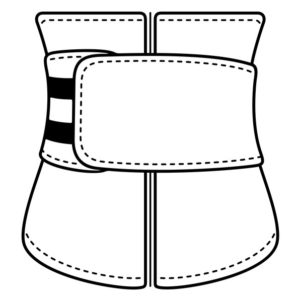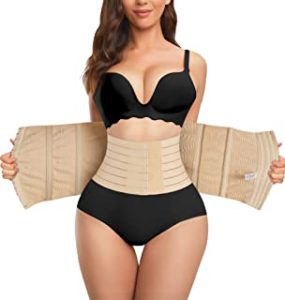Pregnancy comes with a lot of physical and emotional changes, most obviously the stretching of the abdomen to make room as your baby grows. After delivery, it takes the uterus about 6 weeks to return to its pre-pregnancy state, and most of the time, even longer for the abdomen itself to shrink back. However, one of the ways to help make this process faster is to wear a postpartum girdle.
A good postpartum girdle would help your body return to its former shape and support your organs as they return to their previous size after childbirth.
In this article, you’d find all you need to know about postpartum girdles; the types, advantages, risks, and also essential safety tips on how to use them.
What’s A Postpartum Girdle?
A postpartum girdle is sometimes called a belly band or a belly binder. It is a compression garment designed to fit snugly around your tummy and aid postpartum recovery. New moms use girdles to compress their tummies, buttocks, and hips to get that much-desired shapely look.

A good postpartum girdle would tighten the abdominal flab and help your uterus return to its normal size. Although there are many benefits of using a postpartum girdle, it is also important to consider the potential risks involved.
Types of postpartum girdle
1. Elastic Wrap.
This is the best kind of postpartum girdle. In fact, it doesn’t matter if you had a C-section or a vaginal delivery, with the right elastic belly wrap you’d get all the support you need to recover fully.
It is made of soft, elastic fabric that allows you to breathe, move, and shift easily. Furthermore, a good Elastic Wrap Girdle should be long enough to wrap around your hips and your abdomen comfortably.
2. Support Belt
Support belts are really helpful for women with diastasis recti, a muscle injury that occurs during pregnancy, because offer complete compression across the abdomen. In addition, this type of postpartum girdle would strengthen your core and pelvic muscles and also improve your body posture.
You can even get a good Support Belt that comes with adjustable shoulder straps to ensure stability
When Can I Use A Postpartum Girdle?
The answer is really simple: Whenever you’re ready.
However, it is important to speak with your doctor to make sure you’ve got the right girdle for you. Even if you had a C-section, you can begin to use a postpartum belly wrap as early as the first day after your operation (with your doctor’s approval).
Just make sure that you:
- Can breathe properly
- Feel adequately supported
- Move around and bend easily
How Long Can I Wear A Girdle After Childbirth?
In the early days of your postpartum journey, you should only wear a girdle or binder for about 5 hours daily. As the journey progresses, you can gradually increase the duration to about 10 hours per day.

This would help you adjust to the girdle and become more comfortable with it.
How to Select the Right Postpartum Girdle
Your convenience and comfort should always be your priority.
Make sure that the material you want to buy is adjustable and made of soft and comfortable materials. Also, ensure that the girdle fits properly and is not too restrictive. Avoid any band that is too constricting or uncomfortable.
What Are The Advantages of a Postpartum Girdle?
During pregnancy, your organs need to adjust their positions to make room for your little one. In addition, relaxing and other pregnancy hormones relax your pelvic floor in anticipation for childbirth.
In some instances, this can cause urine leakage after delivery.
Wearing a postpartum girdle would provide the right amount of compression needed to hold your muscles in place as your body heals.

A good postpartum girdle would also help you:
- Get relief from postpartum back pain.
- Correct wrong posture
- Become more confident in your own body
- Increase blood flow
- Stabilize your pelvic floor
- Reduce postpartum swelling or edema.
- Improved muscle and incision-site healing (if you had a C-section).
Is There Any Risk Involved?
Although postpartum girdles are medically approved by the Food and Drug Administration (FDA) as a medical device, prolonged or improper expose you to certain risks.

Some of these risks include:
- Abdominal pain
- Itching
- Pelvic floor prolapse
- Excess abdominal pressure
Most of these risks occur because some women wear the wrong kind of belly girdle or because they simply wear it too tightly.
Safety Tips While Using a Postpartum Girdle
It is not compulsory for every woman to wear a girdle. In fact, you may not need it at all in your entire postpartum journey.
Although a good postpartum girdle would reduce the pain from a C-section and support your recovering body, it is important to take note of the following safety tips before buying one.
- Don’t Wear It For Too Long
If you’ve just had your baby, you do not need to wear a girdle for too long.
In fact, what your body needs most in this period is rest. As we mentioned earlier, it is important to start easy; by wearing a postpartum girdle for only about 5 hours daily until you become more comfortable with it.
- Wear It The Right Way
How you wear your girdle is really important. Some experts may even refer to this as the ‘wrap up’.
The most effective way to wear a postpartum girdle is to use an elastic wrap that’s flexible enough to stay firm and allow you to breathe easily. Furthermore, the wrap should be long enough to go round your hips and abdomen.
This is a really important safety tip because wrapping your girdle the wrong way can place downward pressure on your pelvic floor, causing more harm than good.
Conclusion
Yes, a postpartum girdle can help you feel better in the postpartum period. However, it’s not a cure-all. Please, don’t rely on it for complete relief or recovery. Furthermore, it is absolutely important to check in with your doctor before buying and using a postpartum girdle.
Also, a wrap will not take over the functions of your muscles. You should exercise properly to help your pelvic floor muscles heal in time.
Stay strong, Mama.
REFERENCES
E.H. Verstraete, G. Vanderstraeten, and W. Parewijck (2013). Pelvic Girdle Pain during or after Pregnancy: a review of recent evidence and a clinical care path proposal. Facts, Views & Vision in ObGyn; 5(1): 33–43. Accessed on 18th August, 2021 from https://www.ncbi.nlm.nih.gov/pmc/articles/PMC3987347/#__ffn_sectitle
Ando Kazuo, Komatsu Ryu and Flood Pamela (2019). Postpartum chronic pelvic pain and pelvic girdle pain. Minerva anestesiologica. Accessed on 18th August, 2021 from https://www.researchgate.net/publication/334139786_Postpartum_chronic_pelvic_pain_and_pelvic_girdle_pain

